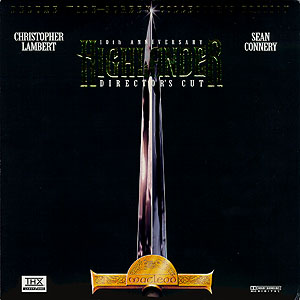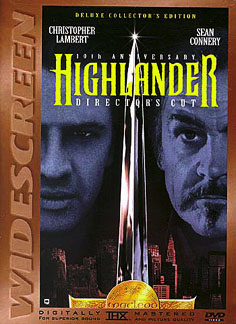Christopher Lambert is Connor MacLoud, a man born in 1518. Sean Connery is Ramirez, an
Egyptian/Spanish nobleman who, like MacLoud, is an immortal - men who cannot die except by beheading. Ramirez
seeks out MacLoud after learning that he has survived a mortal wounding from The Kurgan (Clancy Brown).
MacLoud is trained to fight - to literally save his head so he can prevent the Kurgan from obtaining The
Prize. He has lived out his life - more lifetimes than he desires, participating in pieces of the world's
history, never allowing anyone to discover his true identity. Now, nearly 4½ centuries later, he
continues to be chased by other immortals - including The Kurgan - whose sole desire is to remove his head.
You see, at the time of the "Gathering", there can be only one.
Highlander bounced from one home video company to another after it's theatrical release in 1986.
None of the video versions presented the film to it's highest potential. Previous transfers of the film were
poorly presented in terrible transfers which exhibited excessive grain and video noise. Further the image was
Pan & Scan, and badly at that. On the previous video edition from HBO Home Video through Image Entertainment,
not only is the picture terrible, the audio is dull, muted and lifeless.
Of course, all that has changed. For the film's 10th Anniversary, the filmmakers
went back to the original film elements created a new digital master, incorporating almost six minutes of
footage not seen in the original US theatrical release. Using the original 6-track magnetic masters, a new 5.1
audio soundtrack was also created. An audio commentary by director Russell Mulcahy and producers
Peter Davis and William Panzer was recorded and a still-frame "slide show" of images from all
aspects of the films production, including the script was created. The package was then THX mastered and
certified and released on September 3, 1996 on what was then the premiere home video format, LaserDisc. Fans
everywhere rejoiced at the package (which was over-priced) for we now actually had a good video representation
of a film which sparked two sequels (a third is scheduled to be released in 2000) and two syndicated television
series.
Republic pictures released the DVD version of Highlander during the first year of DVD. The
existing LaserDisc program was lifted directly for the release on DVD. The audio transfer is excellent, with a
very active sound field. It is soncially indistinguishable from the LaserDisc edition. The video transfer,
while derived from the same digital remastered source, is somehow different on this DVD. The DVD presents a
picture which is sharper due to the increased resolution of the DVD medium. A 16x9 enhanced transfer would have
further improved the image. The colors on the DVD are altogether cooler than those on the LaserDisc. I was
torn as to which looked better. Perhaps the LaserDisc for it's warmer colors and the DVD for it's sharpness.
When the DVD was initially released, there were (and still continue to be) very negative comments regarding the
DVD transfer. To these people, I say watch the DVD and compare it to the LaserDisc, not another DVD. There is
no way you can watch the two versions of this film and honestly say the DVD doesn't look great.
 All the supplements from the LaserDisc edition are presented exactly in the same fashion on this DVD. Actually,
the LaserDisc does have on additional piece - Virtual 3-D "Katana" sword. In the early life of DVD, the
program designers were still trying to figure out how to present a series of still images. They didn't have
it quite right yet when Highlander was done. The first complete section including the script
and production information is presented in still frame format which plays out for about 20 seconds. At that
point, the program shifts into the "slide show" presentation. On LaserDisc, the entire sequence is one still
frame after another which when played has the same effect. However, the LaserDisc is encoded with a series of
"automatic picture stops" which re-freeze the image at the beginning of key sequences. It is possible to
duplicate this interaction on DVD today, but in early 1997, the engineers just didn't have the process down yet.
And even now, going backward is a bit tricky. As a result, the supplemental section is superior on the LaserDisc
edition.
All the supplements from the LaserDisc edition are presented exactly in the same fashion on this DVD. Actually,
the LaserDisc does have on additional piece - Virtual 3-D "Katana" sword. In the early life of DVD, the
program designers were still trying to figure out how to present a series of still images. They didn't have
it quite right yet when Highlander was done. The first complete section including the script
and production information is presented in still frame format which plays out for about 20 seconds. At that
point, the program shifts into the "slide show" presentation. On LaserDisc, the entire sequence is one still
frame after another which when played has the same effect. However, the LaserDisc is encoded with a series of
"automatic picture stops" which re-freeze the image at the beginning of key sequences. It is possible to
duplicate this interaction on DVD today, but in early 1997, the engineers just didn't have the process down yet.
And even now, going backward is a bit tricky. As a result, the supplemental section is superior on the LaserDisc
edition.
The audio commentary is identical on both the LaserDisc and the DVD. It contains lots of tid-bit information on
the shooting of the film. Through the commentary, we are given details on what footage was removed for the
US release. The interaction between the producers and director is quite lively and they play off each other
to recall events from ten years earlier.
The Production notes and Cast / Crew information is actually part of the "still frames" section and is not easily
accessed. The menu structure of the DVD is very generic and has no film specific setups. This is likely due to
the early period in which the disc was produced. I would have liked to see a complete restructuring of the
supplemental materials incorporated into a menu structure as has been done more recently with other titles.
There must be a certain amount of personal enjoyment from this film to sit through it. When I was first introduced
to the Highlander series, I saw the 2nd film first - and the theatrical cut at that. The friend I had
seen the film with spent the better part of the next couple of hours explaining what Highlander really was
and that The Quickening was nothing like the first film. Now, years later, having seen the first
film in the form the director intended, I have found a new respect for the picture - and those that followed it.
If you are a fan of the film, I highly recommend picking up either the LaserDisc or the DVD. They both have
strengths and weaknesses. You must weigh which components are most important to you. It will make your decision
a bit easier with the knowledge that the LaserDisc is actually out of print as of this writing. You may still
find retailers with inventory. The DVD edition is readily available and Artisan has just repackaged it with
The Director's Cut - Highlander 2: Renegade Version as a DVD Dual Pack.
A packaging note. The DVD lists the aspect ratio at 2.35:1. This is incorrect, the actual aspect ratio is
1.85:1. |

 All the supplements from the LaserDisc edition are presented exactly in the same fashion on this DVD. Actually,
the LaserDisc does have on additional piece - Virtual 3-D "Katana" sword. In the early life of DVD, the
program designers were still trying to figure out how to present a series of still images. They didn't have
it quite right yet when Highlander was done. The first complete section including the script
and production information is presented in still frame format which plays out for about 20 seconds. At that
point, the program shifts into the "slide show" presentation. On LaserDisc, the entire sequence is one still
frame after another which when played has the same effect. However, the LaserDisc is encoded with a series of
"automatic picture stops" which re-freeze the image at the beginning of key sequences. It is possible to
duplicate this interaction on DVD today, but in early 1997, the engineers just didn't have the process down yet.
And even now, going backward is a bit tricky. As a result, the supplemental section is superior on the LaserDisc
edition.
All the supplements from the LaserDisc edition are presented exactly in the same fashion on this DVD. Actually,
the LaserDisc does have on additional piece - Virtual 3-D "Katana" sword. In the early life of DVD, the
program designers were still trying to figure out how to present a series of still images. They didn't have
it quite right yet when Highlander was done. The first complete section including the script
and production information is presented in still frame format which plays out for about 20 seconds. At that
point, the program shifts into the "slide show" presentation. On LaserDisc, the entire sequence is one still
frame after another which when played has the same effect. However, the LaserDisc is encoded with a series of
"automatic picture stops" which re-freeze the image at the beginning of key sequences. It is possible to
duplicate this interaction on DVD today, but in early 1997, the engineers just didn't have the process down yet.
And even now, going backward is a bit tricky. As a result, the supplemental section is superior on the LaserDisc
edition.